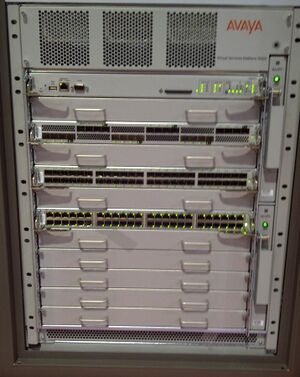Engineering:Avaya VSP 9000 Series
This article has been nominated to be checked for its neutrality. (November 2013) (Learn how and when to remove this template message) |
| Virtual Services Platform 9000 | |
Avaya Virtual Services Platform 9000 Series or VSP 9000 is a set of modular chassis switches used in enterprise and data center networks, manufactured by Avaya. The VSP 9000 is used by institutions which are suffering from performance limitations, need to simplify their network infrastructure in a virtualized environment, or require 10 Gigabit Ethernet today with the option to scale to 40 or 100 Gigabit Ethernet in the future.[1] It is also an option for companies who are looking to reduce the power and cooling cost in order to maximize the cost-effectiveness of their infrastructures; this unit was also designed and is expected to have a lifespan of seven-to-ten years.[2] In 2013 the Olympics network backbone is built with VSP 9000 Switches supporting 30,000 users and up to 54 terabits per second of traffic.[3]
General Specifications
The VSP 9000 Series consists of two Chassis models; the original 9012 Chassis supports twelve (12) horizontally-orientated front-panel slots, ten (10) of which are designated for I/O Modules and two reserved for CPU Modules, and the newer 9010 Chassis that support ten (10) vertically orientated slots, eight (8) for I/O Modules, again with two reserved for CPU Modules. The primary driver for the 9010 Chassis is where there is an exclusive requirement for front-to-back cooling.
The VSP 9000 supports up to 240 10 Gigabit Ethernet ports[4] and is future-ready to support 40 Gigabit Ethernet and 100 Gigabit Ethernet ports which speed over a 100 terabit per second Switch Cluster.[5][6] The chassis also supports Shortest Path Bridging,[7] Provider link state bridging, and Split multi-link trunking at up to 480 trunks with 16 links per trunk group. This product can also maintain over 4000 VLANs and IP interfaces with support for up to ten thousand static IP routes over an IP forwarding table with 500 thousand entires. Some more technological performance measures are as follows:
- VRRP Interfaces: up to 512
- Circuitless IP Instances: up to 256
- ECMP Routes: up to 64k
- RIP Instances: up to 64
- RIP Routes: up to 10k
- OSPF Instances: up to 64
- OSPF Areas: up to 80
- OSPF Adjacencies: up to 512
- OSPF Routes: up to 64k
- BGP Peers: up to 256
- BGP Routes: up to 1,500k
- VRF instances: up to 512[1][page needed]
Rack scalability
- 720 × 10 Gigabit Ethernet ports
- 1440 × 1 Gigabit Ethernet ports
See also
- Avaya
- Avaya Networking Products
- Avaya Government Solutions
- Avaya Professional Credentials
- Shortest Path Bridging
- Terabit Ethernet
- Split multi-link trunking
References
- ↑ 1.0 1.1 "VSP-9000 fact sheet". Avaya. http://www.avaya.com/usa/resource/assets/factsheet/VSP%209000%20DN4535%20final10-10.pdf.
- ↑ *Tim Greene (29 June 2010). "Avaya counters Cisco with VSP 9000 switch". Network World US. http://news.techworld.com/networking/3228514/avaya-counters-cisco-with-vsp-9000-switch/.
- ↑ Nestor E. Arellano (December 2013). "Building a BYOD infrastructure for 30,000 users". IT World Canada. http://www.itworldcanada.com/post/building-a-byod-infrastructure-for-30000-users.James Careless (December 2013). "Avaya builds massive Wi-Fi net for 2014 Winter Olympics". Network World. http://www.networkworld.com/news/2013/121613-avaya-wifi-olympics-276776.html?source=NWWNLE_nlt_network_systems_2013-12-16.
- ↑ Desai, Sonal (15 July 2009), Nortel VSP 9000 Supports 240 Ports of 10Gbps, CXO Today, http://www.cxotoday.com/story/nortel-vsp-9000-supports-240-ports-of-10gbps/, retrieved 2 April 2011
- ↑ Virtual Services Platform 9000 Technical Specifications[yes|permanent dead link|dead link}}]
- ↑ "10 Hot 10-Gigabit Ethernet Products at Interop Las Vegas". CRN. 20 May 2009. http://www.crn.com/slide-shows/networking/217600349/10-hot-10-gigabit-ethernet-products-at-interop-las-vegas.htm?pgno=2.
- ↑ "Avaya rolls out network blueprint for data center". CYBERMEDIA INDIA ONLINE LIMITED. 11 November 2010. http://www.ciol.com/Technology/Networking/Products/Avaya-rolls-out-networking-blueprint-for-data-centre/143333/0/.
Further reading
- Duffy, Jim (18 May 2009). "Nortel continues the enterprise fight". Network World Inc./IDG. https://www.networkworld.com/article/2255284/nortel-continues-the-enterprise-fight.html.
- Berndtson, Chad (10 November 2010). "Avaya Rolls Out Virtual Networking Architecture". CRN UBM plc. http://www.crn.com/news/networking/228200617/avaya-rolls-out-virtual-networking-architecture.htm;jsessionid=FShvhxUv8+JfSQvD9PwefA**.ecappj03.
- "Avaya Data Solutions Launches Virtualization Strategy". Realwire Limited. http://www.realwire.com/releases/Avaya-Data-Solutions-Launches-Virtualization-Strategy.
- Kerner, Sean Michael (20 May 2009). "Nortel Soldiers on With New Networking Gear". Internet News. http://www.internetnews.com/bus-news/article.php/3821461/Nortel+Soldiers+On+With+New+Networking+Gear.htm.
- Chad Berndtson (9 June 2011) Westcon Sees Inroads With Avaya Data Networking CRN
- {{cite web
|title = Avaya extends 'private cloud' capabilities to campus networks |publisher = Computer News Middle East |author = Sathya Mithra Ashok |date = 23 February 2011 |url = http://www.computernewsme.com/2011/02/avaya-extends-private-cloud-capabilities-to-campus-networks/ |access-date = 4 September 2011
External links
| Wikimedia Commons has media related to Avaya. |


